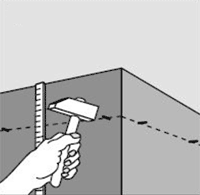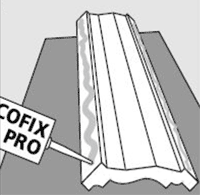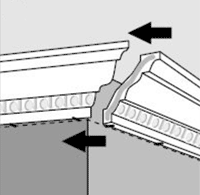Fitting Coving and Cornice
18th July 2017Watch our video guides to cutting and installing coving from the links below .
How to cut Internal corners How to cut Cutting external coving corners Create a Cutting a Stop-End coving section Using Decofix Extra Fix for Perfect Joins
Before You Start : Tools
Saw – a medium tooth, cross-cut saw is best. Choose one with a reasonably stiff blade – if it is too flexible it may bend when cutting the coving, resulting in a curved edge making it difficult to obtain a good fit with the adjoining coving length.
Mitre box – ensure that it is big enough for the coving you are cutting. Remember that the coving is propped against the back plate of the mitre box (see image below) – a common mistake is to lie the coving “flat” and cut as if it was architrave or a picture frame. The coving is always put in the mitre box “upside down” – i.e the edge that will be fixed to the ceiling should be on the base (horizontal section) of the box.
Adhesives – Decofix Pro (or Hydrofix if walls have been recently plastered) for mounting and filling. You will also need Extra Fix cement for all joins (a specialist adhesive that will prevent any cracks appearing later on). Ensure the room temperature is above 10°C otherwise the adhesives won’t bond correctly.
Other tools required will be: Pencil, ruler, spirit level, standard caulking/cartridge gun, hammer and small nails, sponge & water, filling knife, trimming knife, paintbrush (to use when blending in the filler).
Cutting : General Advice
Use a firm, positive stroke of the saw. Don’t try and force the cut or cut too quickly. Hold the coving securely with your non-cutting hand to prevent it slipping or moving in the mitre box. If possible, try and support/raise the other end to the same level throughout so that the cove isn’t sloping along it’s length. Make sure you position the adjustable stops in the mitre box to the correct measurement (the amount that the coving/cornice protrudes across the ceiling). Measure, don’t guess!
Internal corners
![internal-TH[1]](https://www.decorative-coving.co.uk/wp-content/uploads/2018/04/internal-TH1.gif) Look at the diagram to the right carefully. You can click it to enlarge.
Look at the diagram to the right carefully. You can click it to enlarge.
When positioned in the mitre box, the main section of coving that will be hung on the left wall should be to your right, and similarly the main section of coving should be on your left for the piece that will be hung on the right hand wall.
External corners
![external-TH[1]](https://www.decorative-coving.co.uk/wp-content/uploads/2018/04/external-TH1.gif) The same theory applies to external corners, except this time you will be cutting using the opposite 45° guides.
The same theory applies to external corners, except this time you will be cutting using the opposite 45° guides.
See the diagram to the right – again you can click to enlarge.
A stop end is cut the same way as an external corner using a short surplus length.
Hanging
 If you have any external corners (such as a chimney breast), start with them. Otherwise start at the first corner you see when entering the room (it is always easier to get the 1st corner of the installation correct, so make sure it is the most noticeable corner in the room).Establish the drop down the wall from the ceiling that the coving will be fixed at, and ensure this is clean and sound. Draw a line around the room at this position (or mark at various points). Ensure the line is horizontal – do not be tempted to follow the ceiling which may not be level (if there is any subsequent gap, this can be filled later). At every 500mm or so, tap a small pin nail into the wall as a temporary supporting guide. (The small nail holes will eventually be covered by the adhesive/filling compound). For extra adhesion you can score the area between line and the ceiling. Optionally, repeat this process on the ceiling.
If you have any external corners (such as a chimney breast), start with them. Otherwise start at the first corner you see when entering the room (it is always easier to get the 1st corner of the installation correct, so make sure it is the most noticeable corner in the room).Establish the drop down the wall from the ceiling that the coving will be fixed at, and ensure this is clean and sound. Draw a line around the room at this position (or mark at various points). Ensure the line is horizontal – do not be tempted to follow the ceiling which may not be level (if there is any subsequent gap, this can be filled later). At every 500mm or so, tap a small pin nail into the wall as a temporary supporting guide. (The small nail holes will eventually be covered by the adhesive/filling compound). For extra adhesion you can score the area between line and the ceiling. Optionally, repeat this process on the ceiling.
 Now, carefully measure along the wall the length you need – then measure it again! Transfer these measurements to the coving, and if it helps, also mark a line in the direction that the cut will roughly be, so that when put in the mitre box you can be assured you are cutting in the correct direction.
Now, carefully measure along the wall the length you need – then measure it again! Transfer these measurements to the coving, and if it helps, also mark a line in the direction that the cut will roughly be, so that when put in the mitre box you can be assured you are cutting in the correct direction.
Make the cut, then offer up to check you are happy that the 2 sections meet. Don’t worry if they do not meet perfectly – not many rooms have corners that are exactly 90°, so a perfect join is rare. That’s where careful use of the filler comes in later!
Using Decofix Pro or Decofix Hydro, apply along the entire length of the back edges of the coving where it will meet the wall and ceiling. As a rough guide to coverage, a cartridge should be sufficient for 6-8m.
 Using the line on the wall as a guide and the nails as a lever, push the coving firmly into place, adjusting as necessary. Now apply a thin layer of Extra Fix to the end of the coving where it will meet the next piece. This will give an ultra high strength join and prevent any cracks appearing in the future (if applied correctly, the join will be stronger than the actual coving piece itself).
Using the line on the wall as a guide and the nails as a lever, push the coving firmly into place, adjusting as necessary. Now apply a thin layer of Extra Fix to the end of the coving where it will meet the next piece. This will give an ultra high strength join and prevent any cracks appearing in the future (if applied correctly, the join will be stronger than the actual coving piece itself).
Repeat the above process around the rest of the room.
Remove any excess adhesive and use it to fill in any gaps – between joins and between coving and wall/ceiling. Use your finger, a filling knife and a damp paintbrush to smooth over, followed by a wet sponge to wipe off any remaining adhesive. Finally after allowing 3-4 hours for the adhesive to dry, remove the nails and fill the holes as above.
Painting
The coving is pre-finished with an undercoat/primer already applied, so it will be ready to paint after 24 hours. Although any paint is suitable, remember that emulsion is water based. This means that it may suffer hairline cracks if there is excessive movement or vibration in the ceiling. Acrylic/oil based based paints have more “elasticity” in them so are less prone to these fine cracks.
Do you want to download a Word document of this guide?
